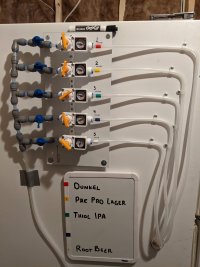- Joined
- Jan 3, 2020
- Messages
- 3,227
- Reaction score
- 3,908
Aw too bad, thought that might be a possibility. I was wondering if there was a pressure differential around the check valve that the end might be dropping temperature/pressure so then CO2 might move past the check valve. The room is unheated potentially based on the insulation showing, but I am not inclined to think that might happen. I think it would require something like the line from the regulator to the check valve to stay warmer than past the check valve. You could take a check valve out of 2-3 circuits to test that. If you tested it overnight before hanging it and everything was stable you could mostly likely rule that out.




![Craft A Brew - Safale BE-256 Yeast - Fermentis - Belgian Ale Dry Yeast - For Belgian & Strong Ales - Ingredients for Home Brewing - Beer Making Supplies - [3 Pack]](https://m.media-amazon.com/images/I/51bcKEwQmWL._SL500_.jpg)























































